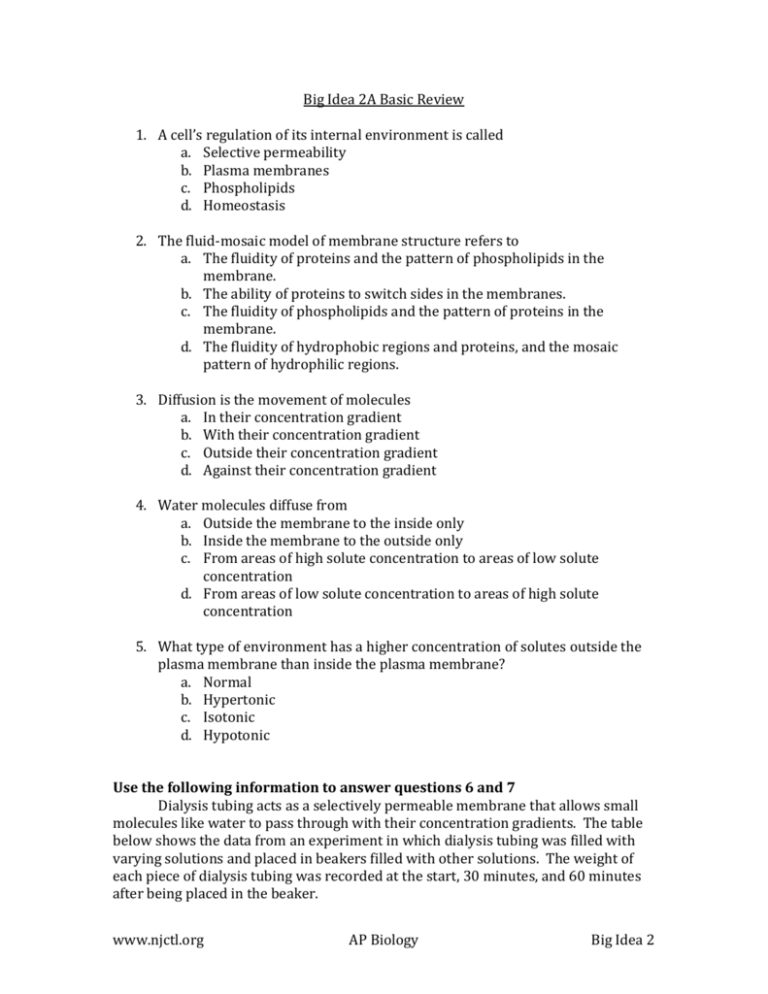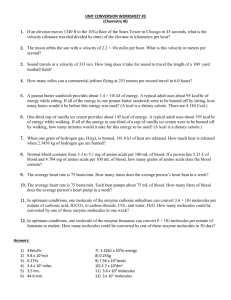Big Idea 2A Basic Review A cell`s regulation of its internal
advertisement

Big Idea 2A Basic Review 1. A cell’s regulation of its internal environment is called a. Selective permeability b. Plasma membranes c. Phospholipids d. Homeostasis 2. The fluid-mosaic model of membrane structure refers to a. The fluidity of proteins and the pattern of phospholipids in the membrane. b. The ability of proteins to switch sides in the membranes. c. The fluidity of phospholipids and the pattern of proteins in the membrane. d. The fluidity of hydrophobic regions and proteins, and the mosaic pattern of hydrophilic regions. 3. Diffusion is the movement of molecules a. In their concentration gradient b. With their concentration gradient c. Outside their concentration gradient d. Against their concentration gradient 4. Water molecules diffuse from a. Outside the membrane to the inside only b. Inside the membrane to the outside only c. From areas of high solute concentration to areas of low solute concentration d. From areas of low solute concentration to areas of high solute concentration 5. What type of environment has a higher concentration of solutes outside the plasma membrane than inside the plasma membrane? a. Normal b. Hypertonic c. Isotonic d. Hypotonic Use the following information to answer questions 6 and 7 Dialysis tubing acts as a selectively permeable membrane that allows small molecules like water to pass through with their concentration gradients. The table below shows the data from an experiment in which dialysis tubing was filled with varying solutions and placed in beakers filled with other solutions. The weight of each piece of dialysis tubing was recorded at the start, 30 minutes, and 60 minutes after being placed in the beaker. www.njctl.org AP Biology Big Idea 2 Tube Number 1 2 3 4 Dialysis Tubing Contents Distilled Water 10% Sucrose 40% Sucrose Distilled Water Beaker Contents Distilled Water Distilled Water Distilled Water 40% Sucrose Mass (g) 0 mins Mass (g) 30 mins Mass (g) 60 mins 23.4 23.3 23.4 25.9 26.8 28.0 26.2 28.6 30.7 23.8 21.5 19.7 6. Why does the mass of tube 4 decrease while the mass of tube 3 increases? a. Water is moving out of tube 4, and sucrose is moving out of tube 3. b. Water is moving out of tube 4, and water is moving into tube 3. c. Sucrose is moving into tube 4, and water is moving into tube 3. d. Water is moving into tube 4, and sucrose is moving into tube 3. 7. Which best describes the movement of molecules in tube 2? a. Only water is moving into the tube. b. Only water is moving out of the tube. c. Water and sucrose are moving into the tube. d. Water is moving into the tube and sucrose is moving out. 8. Active transport moves molecules a. Against their concentration gradients without the use of energy b. Against their concentration gradients using energy c. With their concentration gradients without the use of energy d. With their concentration gradients using energy 9. Which protein can be used for both active and passive transport? a. Any transmembrane protein b. Any integral protein c. Carrier protein d. Channel protein 10. Catabolic pathways a. Release energy by breaking down complex molecules into simpler molecules b. Consume energy by breaking down complex molecules into simpler molecules c. Release energy by building complex molecules from simpler molecules www.njctl.org AP Biology Big Idea 2 d. Consume energy by building complex molecules from simpler molecules 11. A spontaneous reaction is one that a. Happens quickly in one direction only b. Happens quickly in the forward and reverse reactions c. Occurs without outside intervention and in one direction only d. Occurs without outside intervention and in the forward and reverse directions 12. An exergonic reaction is a reaction that a. Occurs spontaneously with a negative ∆G b. Does not occur spontaneously and has a negative ∆G c. Occurs spontaneously with a positive or zero ∆G d. Does not occur spontaneously and has a positive or zero ∆G 13. In an endergonic reaction a. The reactants have more free energy than the products b. The products have more free energy than the reactants c. The reactants and products have equal amounts of free energy d. Free energy is released 14. A spontaneous reaction a. Occurs only when an enzyme or other catalyst is present b. Releases free energy when proceeding in the forward direction c. Is common in anabolic pathways d. Leads to a decrease in the entropy of the universe 15. Which of the following correctly states the relationship between catabolic and anabolic pathways? a. Anabolic pathways synthesize more complex organic molecules using the energy derived from catabolic pathways b. Degradation of organic molecules by anabolic pathways provides the energy to drive catabolic pathways c. Energy derived from catabolic pathways is used to drive the breakdown of organic molecules in anabolic pathways d. Synthesis of complex organic molecules in anabolic pathways is used to drive the breakdown of complex molecules in catabolic pathways 16. Anabolism is to catabolism as ____________________ is to ________________________. a. spontaneous; exergonic b. endergonic; exergonic c. order; entropy d. entropy; free energy www.njctl.org AP Biology Big Idea 2 17. Activation energy is __________________________________________. a. the energy given off when reactants collide b. generally very high for a reaction that takes place rapidly c. the heat released in a reaction d. an energy barrier between reactants and products 18. Why does a catalyst cause a reaction to proceed faster? a. There are more frequent collisions and they are of greater energy. b. Only because there are more collisions per second. c. Only because collisions occur with greater energy. d. Only because the activation energy is lowered. 19. The active site of an enzyme I. Can be used again and again. II. Is not affected by environmental factors. III. Is the part of the enzyme where the substrate can fit. a. b. c. d. I only III only I and III I, II, and III 20. If an enzyme has been inhibited noncompetitively, a. The enzyme is able to increase its activity. b. The active site will change shape. c. The active site will be occupied by the inhibitor molecule. d. Increasing substrate concentration will increase inhibition. 21. Which of the following is not part of allosteric regulation? a. Regulatory molecules bind to a site separate from the active site. b. A naturally occurring molecule stabilizes the active conformation. c. A copy of the substrate competes for the active site. d. Inhibitors and activators may compete with one another. www.njctl.org AP Biology Big Idea 2 22. Using the graph above. If enzyme concentration remains constant, why does the graph level off at high substrate concentrations? a. There is no more substrate to be converted into product. b. Substrate concentration exceeds enzyme concentration and all active sites are full. c. All the enzyme is used up, and the product formation cannot occur without it. d. The reaction has run to completion. 23. Osmosis is a form of passive transport that occurs across all membranes. a. Draw and label a diagram of a cell in each of the following solutions: hypertonic, hypotonic, and isotonic. Be sure to identify where the solute concentrations are higher/lower and the direction of the water movement. b. Explain the consequences of having too much water enter the cell or leave the cell. 24. Gibbs free energy is a defining factor in whether or not a reaction will occur spontaneously. a. Explain the relationship between ∆G and the spontaneity of a reaction. b. Explain why living organisms need to couple reactions. 25. Enzymes serve as biological catalysts and are found in all living things. a. Draw and label the catalytic cycle. b. Describe how an enzyme acts as a catalyst. Identify two environmental factors that can affect the ability of an enzyme to catalyze reactions. www.njctl.org AP Biology Big Idea 2 Answers 1. d 2. c 3. b 4. d 5. b 6. b 7. d 8. b 9. c 10. a 11. c 12. a 13. b 14. b 15. a 16. b 17. d 18. d 19. d 20. b 21. c 22. b 23. a. Hypertonic solution- solution has more solutes than the cell, net movement of water out of the cell. Isotonic solution- solution has the same concentration of solutes as the cell, equal movement of water molecules across the membrane. Hypotonic solution- solution has less solutes than the cell, net movement of water into the cell b. If too much water enters the cell it can swell and burts/lyse. If to much water leaves the cell it can shrink or shrivel up. 24. a. If Gibbs free energy or ∆G is negative for a particular reaction, then the reaction will occur spontaneously. If ∆G is positive or zero, then the reaction will not occur spontaneously. b. Living organisms have specific endergonic reactions that they need to perform. Since these endergonic reactions do not occur spontaneously, the endergonic reaction will couple with a exergonic reaction therefore using the energy released from the exergonic reaction to power the endergonic reaction. In these coupled reactions the total ∆G is negative indicating that the coupled reactions occur spontaneously or without the input of other outside energy. 25. a. Drawing should be circular and show substrates binding to the enzyme at the active site and then being released as products and then the enzyme having an empty site for which new substrates can bind to. b. Enzymes act as catalysts by lowering the activation energy required for a chemical reaction to occur. Two environmental factors that affect the ability of an enzyme to catalyze reactions are pH and temperature. www.njctl.org AP Biology Big Idea 2








